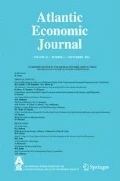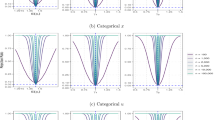Conclusion
This paper reviews two models of selectivity and gives an interpretation of the covariance terms that are particular to self-selectivity models. While the second model examined in this paper has been discussed elsewhere, the estimates presented for the first model have not been discussed in previous papers. More importantly though, the paper proposes an hypothesis about the expected relationship between error covariances. According to this hypothesis, if all individuals who are faced with the choice between two regimes (1 and 2) choose the regime which yields a maximum value, then the expected relationship between covariances is σ1 ∈ < σ2 ∈. If all individuals choose that regime which yields a minimum value, then the expected relationship between covariances is σ1 ∈ > σ2 ∈. This relationship holds for a very general class of selectivity models, so long as individuals are choosing between regimes by comparing the expected value (to them) of each regime.
Similar content being viewed by others
References
J. Heckman, “The Common Structure of Statistical Models of Truncation, Sample Selection and Limited Dependent Variables and a Simple Estimator for Such Models,”Annals of Economic and Social Measurement, 5, pp. 475–92, Fall 1976.
L. Kenny, L. F. Lee, G. S. Maddala and R. P. Trost, “Returns to College Education: An Investigation of Self-Selection Bias Based on the Project Talent Data,”International Economic Review, 20 (3), pp. 775–89, October 1979.
L. F. Lee, “Unionism and Wage Rates: A Simultaneous Equations Model with Qualitative and Limited Dependent Variables,”International Economic Review, 19, pp. 415–34, July 1978.
L. F. Lee, G. S. Maddala and R. P. Trost, “On the Asymptotic Covariance Matrices of Two Stage Probit and Two Stage Tobit Methods for Simultaneous Equations Models with Selectivity,”Econometrica, 48, pp. 491–502, March 1980.
G. S. Maddala, “Self-Selectivity Problems in Econometric Models,”Applications of Statistics, P. R. Krishniah, ed., 1977a.
--, “Identification and Estimation Problems in Limited Dependent Variable Models,”Natural Resources, Uncertainty and General Equilibrium Systems, Essays,” in memory of Rafael Lusky, G. S. Maddala and P. Friedman, ed., 1977b.
F. D. Nelson, “Censored Regression Models with Unobserved, Stochastic Censoring Thresholds,”Journal of Econometrics, pp. 309–27, November 1977.
R. B. Roberts, G. S. Maddala, and G. Enholm, “Determinants of the Requested Rate of Return and the Rate of Return Granted in a Formal Regulatory Process,”The Bell Journal of Economics, 9(2), pp. 611–21, Autumn 1978.
H. S. Rosen, “Housing Decisions and the U.S. Income Tax, An Econometric Analysis,”Journal of Public Economics, 11, pp. 1–23, 1979.
Author information
Authors and Affiliations
Additional information
This paper was written while I was working under the professional development program at CNA.
Rights and permissions
About this article
Cite this article
Trost, R.P. Interpretation of error covariances with nonrandom data: An empirical illustration of returns to college education. Atlantic Economic Journal 9, 85–90 (1981). https://doi.org/10.1007/BF02300600
Issue Date:
DOI: https://doi.org/10.1007/BF02300600




